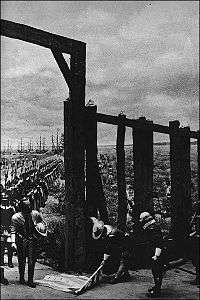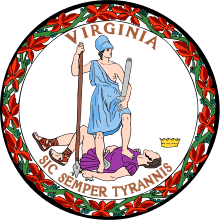Thomas West, 3rd Baron De La Warr


Thomas West, 3rd and 12th Baron De La Warr /ˈdɛləwɛər/ (9 July 1577 – 7 June 1618) was an English politician, for whom the bay, the river, and, consequently, a Native American people and U.S. state, all later called "Delaware", were named. "De La Warr" is pronounced "Delaware".[1][2][3]
There have been two creations of Baron De La Warr, and West came from the second. He was the son of Thomas West, 2nd Baron De La Warr, of Wherwell Abbey in Hampshire and Anne Knollys, daughter of Catherine Carey; making him a great-grandson of Mary Boleyn. He was born at Wherwell, Hampshire, England, and died at sea while travelling from England to the Colony of Virginia.
Biography
Thomas West received his education at Queen's College, Oxford. He served in the army under Robert Devereux, 2nd Earl of Essex, and, in 1601, was charged with supporting Essex's ill-fated insurrection against Queen Elizabeth, but he was acquitted of those charges.[4] He succeeded his father as Baron De La Warr in 1602, and became a member of the Privy Council.[5]
Lord De La Warr was appointed governor-for-life and captain-general of the Colony of Virginia, to replace the governing council of the colony under the presidency of Captain John Smith.[6] Subsequently, in November 1609, the Powhatan tribe of Native Americans killed John Ratcliffe, the Jamestown Colony's Council President, and attacked the colony in what became the First Anglo-Powhatan War.[7] As part of England's response, De La Warr recruited and equipped a contingent of 150 men and outfitted three ships at his own expense, and sailed from England in March 1610. They arrived in Jamestown in June, just in time to persuade the original settlers not to give up and go home to England. As a veteran of destructive English campaigns against the Irish, De La Warr employed similar "scorched earth" tactics against the Native Americans: his troops raided villages, burned houses, torched cornfields, and stole provisions. These tactics, identical to those practiced by the Powhatan themselves, proved effective.
Lord De La Warr returned to England due to illness in the spring of 1611, leaving his deputy, Sir Samuel Argall, in charge of the colony. Later that year, De La Warr wrote and published a book titled The Relation of the Right Honourable the Lord De-La-Warre, Lord Governour and Captaine Generall of the Colonie, planted in Virginea.[8] He remained the nominal governor, and after receiving complaints from the Virginia settlers about Argall's tyranny in governing them on his behalf, Lord De La Warr set sail for Virginia again in 1618 to investigate those charges. He died at sea en route to Virginia.[4]
It was thought for many years that Lord De La Warr had been buried in the Azores or at sea.[4] By 2006, researchers had concluded that his body was brought to Jamestown for burial. A grave site thought to contain the remains of Captain Bartholomew Gosnold may instead contain those of Lord De La Warr.[9]
Lord De La Warr's brother, John West, later became governor of Virginia, and George Percy's daughter married the son of Governor West.
Family
On 25 November 1596, De La Warr married Cecily (died c. 1662), the daughter of Sir Thomas Shirley of Wiston, Sussex and Anne, daughter of Sir Thomas Kempe.[10] They had children:
- Cecily or Cecilia (died February 1638), who married firstly Sir Francis Bindlosse and secondly after 1629 John Byron, 1st Baron Byron. She was buried at Hucknall-Torkard in Nottinghamshire.[11]
- Lucy, who married Sir Robert Byron (d. after 1643), Governor of Liverpool and a Colonel in the service of the Royalist Infantry Forces who fought in the English Civil War.[12]
- Robert, who married Elizabeth Coch.[13]
- Henry (1603–1628), who succeeded his father as the 4th Baron De La Warr, married Isabella, daughter of Sir Thomas Edmunds, in March 1625. He died at the age of 24 and was succeed by his son Charles West, 5th Baron De La Warr.[14]
- Martha (born 1615), who married William Woodward,[15] an interpreter to the Indians.
Ancestry
| Ancestors of Thomas West, 3rd Baron De La Warr | |||||||||||||||||||||||||||||||||||||||||||||||||||||||||||||||||||||||||||||||||||||||||||||||||||||||||||||||||||||||||||||||||||||||||||||||||||||||||||||||||||||||||||||||||||||||||||||||||||||||||||||||||||||||||||||||||||||||||||||||||||||||||||||||||||||||||||||||||||||||||||||||||||||||||||||||||||||||||||||||||||||||||||||||||||||||||||||||||||||||||||||||||||||||||||||||||||||||||||||||||||||||||||||||||||||||||||||||
|---|---|---|---|---|---|---|---|---|---|---|---|---|---|---|---|---|---|---|---|---|---|---|---|---|---|---|---|---|---|---|---|---|---|---|---|---|---|---|---|---|---|---|---|---|---|---|---|---|---|---|---|---|---|---|---|---|---|---|---|---|---|---|---|---|---|---|---|---|---|---|---|---|---|---|---|---|---|---|---|---|---|---|---|---|---|---|---|---|---|---|---|---|---|---|---|---|---|---|---|---|---|---|---|---|---|---|---|---|---|---|---|---|---|---|---|---|---|---|---|---|---|---|---|---|---|---|---|---|---|---|---|---|---|---|---|---|---|---|---|---|---|---|---|---|---|---|---|---|---|---|---|---|---|---|---|---|---|---|---|---|---|---|---|---|---|---|---|---|---|---|---|---|---|---|---|---|---|---|---|---|---|---|---|---|---|---|---|---|---|---|---|---|---|---|---|---|---|---|---|---|---|---|---|---|---|---|---|---|---|---|---|---|---|---|---|---|---|---|---|---|---|---|---|---|---|---|---|---|---|---|---|---|---|---|---|---|---|---|---|---|---|---|---|---|---|---|---|---|---|---|---|---|---|---|---|---|---|---|---|---|---|---|---|---|---|---|---|---|---|---|---|---|---|---|---|---|---|---|---|---|---|---|---|---|---|---|---|---|---|---|---|---|---|---|---|---|---|---|---|---|---|---|---|---|---|---|---|---|---|---|---|---|---|---|---|---|---|---|---|---|---|---|---|---|---|---|---|---|---|---|---|---|---|---|---|---|---|---|---|---|---|---|---|---|---|---|---|---|---|---|---|---|---|---|---|---|---|---|---|---|---|---|---|---|---|---|---|---|---|---|---|---|---|---|---|---|---|---|---|---|---|---|---|---|---|---|---|---|---|---|---|---|---|---|---|---|---|---|---|---|---|---|---|---|---|---|---|---|---|---|---|---|---|---|---|---|---|---|---|---|---|---|---|---|---|---|---|---|---|---|---|
| |||||||||||||||||||||||||||||||||||||||||||||||||||||||||||||||||||||||||||||||||||||||||||||||||||||||||||||||||||||||||||||||||||||||||||||||||||||||||||||||||||||||||||||||||||||||||||||||||||||||||||||||||||||||||||||||||||||||||||||||||||||||||||||||||||||||||||||||||||||||||||||||||||||||||||||||||||||||||||||||||||||||||||||||||||||||||||||||||||||||||||||||||||||||||||||||||||||||||||||||||||||||||||||||||||||||||||||||
Notes
- ↑ Németh, Robert Stuart (13 September 2006). "The De La Warr Pavilion". Building Opinions. Latest Homes. Archived from the original on 2013-07-13.
- ↑ Billings, Warren M. "Thomas West, Twelfth Baron De La Warr (1576–1618)". Dictionary of Virginia Biography. Encyclopedia Virginia. Retrieved 2015-03-23.
- ↑ "Delaware Place Names" (PDF) (Report). United States Geological Survey.
- 1 2 3
 Lee, Sidney, ed. (1899). "West, Thomas (1577–1618)". Dictionary of National Biography. 60. London: Smith, Elder & Co. pp. 344–45.
Lee, Sidney, ed. (1899). "West, Thomas (1577–1618)". Dictionary of National Biography. 60. London: Smith, Elder & Co. pp. 344–45. - ↑ Fiske, John (1897). Old Virginia and Her Neighbours. 1. Boston and New York: Houghton, Mifflin and Company. pp. 146–47.
- ↑ "The Jamestown Chronicles Timeline", 12 May 2016
- ↑ Lamont, Edward M. (2014). The Forty Years that Created America: The Story of the Explorers, Promoters, Investors, and Settlers Who Founded the First English Colonies. Rowman & Littlefield. p. 121. ISBN 9781442236608.
- ↑ De La Warr, Thomas West, Baron (1611). The Relation of the Right Honourable the Lord De-La-Warre, Lord Governour and Captaine Generall of the Colonie, planted in Virginea at Archive.org.
- ↑ The Virginia Gazette Archived 29 November 2014 at the Wayback Machine., 22 March 2006(?).
- ↑ Lundy 2011, pp. 14230 §142296, 20756 §207556, §207558, citing Cokayne 2000, p. 161.
- ↑ Lundy 2011, p. 14230 §142295 §142296, citing Cokayne 1983, p. 140, Hammond 1998, p. 128, Mosley 2003, p. 630.
- ↑ Lundy 2011, pp. 13955 §139543, 14230 §142296, citing Mosley 2003, pp. 630, 1075.
- ↑ Lundy 2011, pp. 14230 §142296, 24497 §244965, citing Mosley 2003, p. 1075.
- ↑ Lundy 2011, pp. 14230 §142296, 20756 §207553, citing Cokayne 2000, p. 161, Mosley 2003, p. 1075.
- ↑ "Martha West". www.geneall.net. Retrieved December 2013. Check date values in:
|access-date=(help)
References
- Lundy, Darryl Roger, ed. (23 February 2011). "Thomas West, 3rd Baron Delaware". The Peerage. pp. 14230 at §142296, 13955 at §139543, 14230 at §142295–§142296, 20756 at §207553, §207556, §207558, 24497 at §244965.
- Cokayne, George Edward, ed. (1983) [c. 1900]. The Complete Baronetage. 2 (5-volume reprint ed.). Gloucester, U.K.: Alan Sutton Publishing. p. 140.
- Cokayne, George Edward; et al., eds. (2000) [1910–1959]. The Complete Peerage of England, Scotland, Ireland, Great Britain and the United Kingdom, Extant, Extinct or Dormant. 4 (reprint in 6 volumes; new ed.). Gloucester, U.K.: Alan Sutton Publishing. p. 160.
- Mosley, Charles, ed. (2003). Burke's Peerage, Baronetage & Knightage. 1 (107th ed.). Wilmington, Delaware, U.S.A.: Burke's Peerage (Genealogical Books). pp. 630, 1075.
- Hammond, Peter W., ed. (1998). The Complete Peerage or a History of the House of Lords and All its Members From the Earliest Times, Volume XIV: Addenda & Corrigenda. Stroud, Gloucestershire, U.K.: Sutton Publishing. p. 128.
External links
- Biography at Encyclopedia Virginia
 "De la Warr, Thomas West, Lord". New International Encyclopedia. 1905.
"De la Warr, Thomas West, Lord". New International Encyclopedia. 1905.
| Peerage of England | ||
|---|---|---|
| Preceded by Thomas West |
Baron De La Warr 1602–1618 |
Succeeded by Henry West |
| Government offices | ||
| Preceded by Thomas Gates |
Colonial Governor of Virginia 1610-1611 |
Succeeded by George Percy |
